
About UsThe Numismatic Bibliomania Society is a non-profit organization promoting numismatic literature. For more information please see our web site at coinbooks.org SubscriptionsThose wishing to become new E-Sylum subscribers (or wishing to Unsubscribe) can go to the following web page link MembershipThere is a membership application available on the web site Membership Application To join, print the application and return it with your check to the address printed on the application. Membership is only $15 to addresses in the U.S., $20 for First Class mail, and $25 elsewhere. For those without web access, write to: David M. Sundman, Secretary/TreasurerNumismatic Bibliomania
Society AsylumFor Asylum mailing address changes and other membership questions, contact David at this email address: dsundman@LittletonCoin.com SubmissionsTo submit items for publication in The E-Sylum, just Reply to this message, or write to the Editor at this address: whomren@coinlibrary.com
BUY THE BOOK BEFORE THE COINYou won't regret it! |
- WAYNE'S WORDS: THE E-SYLUM APRIL 22, 2012
- REMINDER: KOLBE & FANNING BUY OR BID SALE CLOSES MAY 9, 2012
- SKLOW TO SET UP AT MAY 2012 DENVER ANA SHOW
- NEW BOOK: A STUDY OF ANCIENT SOUTH ASIAN COINS
- NEW BOOK: JODHPUR STATE: HISTORY AND COINAGE
- ZIELINSKI REPORTS ERRORS IN THE 2013 RED BOOK
- SOME WHITMAN PUBLISHING HISTORY
- JORDAN TO SPEAK ON AMERICAN NUMISMATIC ICONOGRAPHY
- EXHIBIT: PANORAMIC VIEWS ON EUROPEAN COINS AND MEDALS
- SHAKESPEAREAN NUMISMATICS AT THE BRITISH MUSEUM
- QUERY: LITERATURE ON PALESTINIAN NUMISMATICS
- PREMIUMS PAID FOR POSTAGE AND FRACTIONAL CURRENCY
- MORE ON THE JOHN ORTH 'BIT' DENOMINATION TOKENS
- QUERY: INFORMATION ON LONGINES WITTNAUER MEDALS SOUGHT
- HARVEY STACK RECALLS HARRY W. BASS, JR
- NOTES FROM E-SYLUM READERS: APRIL 22, 2012
- COINSWEEKLY ARTICLE SPURS CLEANUP OF GREEK TEMPLE SITE
- UTAH GOVERNOR SIGNS GOLD AND SILVER COIN LEGAL TENDER ACT
- 1792 SILVER CENTER CENT SELLS FOR $1.15 MILLION
- CANADA INTRODUCES NEW COIN TECHNOLOGY
- EBAY'S COIN AUCTION RULE CHANGES
- HELL BANKNOTE SEEN AS THREAT
- BURIED NUMISMATIC TREASURE
- FEATURED WEB PAGE: INDIAN PRINCELY STATES AND COINS
WAYNE'S WORDS: THE E-SYLUM APRIL 22, 2012

New subscribers this week include Ed Hohertz, Julio Nunes, Al Cobb Sr., Joe Ferrand, Jim Buggie, Angie Moore, Barry Stallard and Steve Hose. Welcome aboard! We have 1,540 email subscribers, plus 173 followers on Facebook.
What a great crop of new subscribers! They're in for a treat - tonight's issue is a nice one. We open with updates from numismatic literature dealers David Fanning and David Sklow, followed by notices of two new books and a review of the 2013 Guide Book of United States Coins.
Other topics include Indian coinage, numismatic lectures and exhibits around the world, Harry W. Bass, Utah's legal tender act, eBay policy changes, Canada's new coin technology and Hell bank notes.
To learn more about premiums paid for postal and fractional currency, the artistic tradition of
the city view on coins and medals, and the role of money in the Elizabethan and Jacobean theatre,
read on.
Have a great week, everyone!
REMINDER: KOLBE & FANNING BUY OR BID SALE CLOSES MAY 9, 2012
QUICK QUIZ: Who is that funky dancing moneyer on the sale cover? Who can tell us where the image came from? -Editor
 Kolbe & Fanning Numismatic Booksellers are announcing their first "Buy or Bid Sale," which is in
progress and will close on Wednesday, May 9. The sale is designed to sell hundreds of lots
cheaply, giving collectors an opportunity to add to their libraries at inexpensive prices.
Kolbe & Fanning Numismatic Booksellers are announcing their first "Buy or Bid Sale," which is in
progress and will close on Wednesday, May 9. The sale is designed to sell hundreds of lots
cheaply, giving collectors an opportunity to add to their libraries at inexpensive prices.
The sale is online only: there will be no printed catalogue. The PDF catalogue is available now for downloading from the Kolbe & Fanning website at www.numislit.com.
As the name of the sale suggests, customers may bid on items they wish to acquire or buy them outright at the published price. The Terms of Sale will give full instructions on how to participate.
The sale consists of over 1000 items that have remained unsold in previous mail-bid sales. "Buy" prices have been kept low to promote sales. To further encourage participation, the firm is offering free postage to addresses in the U.S. for bidders spending at least $500; there will also be no packing and processing fee for this sale. Again, please read the Terms of Sale before participating.
The sale includes works on ancient, medieval and modern coins, as well as general works, periodicals and sale catalogues. The catalogue is organized into broad categories for the convenience of the reader.
If you have any questions about the sale, please write to David Fanning at df@numislit.com. He can also be reached at (614) 414-0855.
Thank you in advance for your participation. Download the sale today: www.numislit.com .
SKLOW TO SET UP AT MAY 2012 DENVER ANA SHOW
Mail bid sale # 16 is closing June 2, 2012. Catalogs have been shipped to all individuals on our mailing list. Catalogs are available on request At no charge.
I will be set up at the ANA national money show in Denver, Colorado Thursday-Saturday May 10, 11 & 12 (table # 130). Stop by, say hello, sit down, and let's talk about numismatic literature.
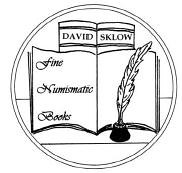 DAVID SKLOW - FINE NUMISMATIC BOOKS
DAVID SKLOW - FINE NUMISMATIC BOOKS
P.O. BOX 6321
COLORADO SPRINGS, CO 80934
TEL: (719) 302-5686
FAX: (719) 302-4933
finenumismaticbooks@aol.com
www.finenumismaticbooks.com
NEW BOOK: A STUDY OF ANCIENT SOUTH ASIAN COINS
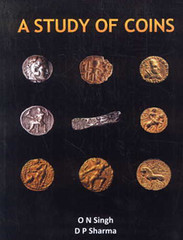 This book "A Study of Coins" covers Numismatic studies of South Asia from earliest time to modern
period. The Ancient South Asian coinages have a very long and varied historical tradition
providing a rich source of information. This part on Punch marked to Gupta Period will serve the
needs of students and academicians, who want to study the coins from ancient to modern times. This
is the first kind of study, which will highlight from the first Punch marked coins issued between
7-6 century BC to present era.
This book "A Study of Coins" covers Numismatic studies of South Asia from earliest time to modern
period. The Ancient South Asian coinages have a very long and varied historical tradition
providing a rich source of information. This part on Punch marked to Gupta Period will serve the
needs of students and academicians, who want to study the coins from ancient to modern times. This
is the first kind of study, which will highlight from the first Punch marked coins issued between
7-6 century BC to present era.
The present volume deals with manufacturing techniques, style and types of metals used symbols and images purpose and dynasties who promoted various kinds of coinage. This book contains seven chapters.
Contents: Preface. Introduction. 1. Early coins of India. 2. Tribal coins of ancient India. 3. Indo-Greek coins. 4. Roman coins in India. 5. Kushana dynasty and their coins. 6. Satavahana coins. 7. Gupta coins. Bibliography. Index.
O. N. Singh, D.P. Sharma (ed.), A Study of Coins. New Delhi, Kaveri Books 2011. 126 p., 50 col. plates, ISBN: 9788174791115. US$55 (inclusive of airmail postage).
To read the complete article, see: Studies of South Asian Numismatics (www.muenzenwoche.de/en/page/4?&id=1151)
To order, see: A Study of Coins (www.vedamsbooks.com/no105129/study-coins-on-singh-dp-sharma)
NEW BOOK: JODHPUR STATE: HISTORY AND COINAGE
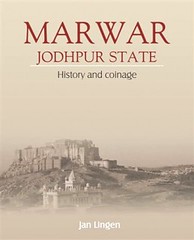 Marwar. Jodhpur State: History and Coinage
Marwar. Jodhpur State: History and Coinage
Authors: Jan Lingen
Format: Hardcover
ISBN-13: 9788186786307
Pages: 208p., 502 Colour & B/W Illustrations; 2 Appendice; Bibliography; 280x220mm.
Pub. date: 18.04.2012, 1st. ed.
Publisher: IIRNS Publications
Language (s): English
Not too long ago, the rajas, maharajas, and nawabs held sway over almost half of India. There were more than five hundred and fifty princely states. Some had vast territories under them, others were smaller; some were very powerful, others were not so powerful. Many of these princely states or native states, as they are also called, issued their own coinages. These, though relatively recent, are amongst the least researched and published coins in Indian numismatics. Books by W.W. Webb, Currencies of the Hindu States of Rajputana (1893), and B.N. Reu, Coins of Marwar (1946), on the coins of the princely states of Rajputana, home to some of the powerful and bigger states, have long been out of date.
The present work, providing a detailed and updated illustrated account of the coinage of Jodhpur state, is, therefore, a very welcome addition to the Indian numismatics. An introduction to the history and coinage of Marwar is followed by the catalogue of coins in 20 chapters. Attractively printed in colour, there are 454 illustrations and line drawings of coins and 48 coloured images of kings, princes, palaces, etc.
At the end, a very instructive chapter on the Mints in Jodhpur State from the Official Gazette of Jodhpur written in Vikram Samvat 1940 (1883-84) is reproduced with an English translation. The book, resulting from the author's painstaking research of more than three decades and his vast expertise on the subject, will remain the most comprehensive work on the coinage of Jodhpur State for a long time to come.
For more information, see:
Marwar. Jodhpur State: History and Coinage
(www.bagchee.com/books/BB72377/marwar-jodhpur
-state-history-and-coinage)
ZIELINSKI REPORTS ERRORS IN THE 2013 RED BOOK
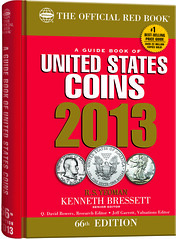 Over the weekend, I picked up the 2013 copy of The Official Red Book: A Guide Book of United
States Coins. I purchase the new edition of the book every year and refer to it several times per
day. This single book puts an incredible amount of information on United States coins at my
fingertips for quick and easy reference.
Over the weekend, I picked up the 2013 copy of The Official Red Book: A Guide Book of United
States Coins. I purchase the new edition of the book every year and refer to it several times per
day. This single book puts an incredible amount of information on United States coins at my
fingertips for quick and easy reference.
I recommend that all coin collectors have a new or recent edition of the Red Book within their numismatic library. It can also make a great gift for someone just starting out in coin collecting. When I first started collecting, I used my first copy of the Red Book until the binding broke. Now, I always purchase the spiral bound version.
When flipping through the newest edition, I did notice a few errors, some of which have also appeared in previous editions. These are not typos or minor differences in figures, but more significant issues that could potentially have an impact on someone relying on the information presented. I also noted a few omissions which could be updated with available information.
Here are some issues that I hope the editors of the Red Book will look into before the release of the next edition:
2008-P and 2008-D Sacagawea Dollars
The Red Book lists mintages of 9,800,000 and 14,840,000 for the 2008-P and 2008-D Sacagawea
Dollars. These coins were only issued by the United States Mint within numismatic rolls and bags,
and the total mintages were significantly lower at 1,820,000 each.
The basis for the incorrect higher numbers seems to be the US Mint's 2008 circulating coin production figures, which include a large number of 2009 Native American Dollars that were struck during December 2008.
Correspondingly, the 2009 Native American Dollar mintages in the Red Book should be higher by the displaced amount.
1999 Yellowstone National Park Silver Dollar
The Red Book lists mintages for the 1999 Yellowstone Silver Dollar of 23,614 uncirculated coins
and 128,646 proof coins. The figures that I have are 82,563 uncirculated coins and 187,595 proof
coins. I believe that the mistake is the result of not including sales for coins included in the
two coin set offered by the US Mint for the program.
The figure reported for the uncirculated version would place this issue amongst the lowest mintage modern commemorative silver dollars. The correct figure puts the coin back into the average mintage range.
Omissions
There is no mintage listed for the 1999 Proof Susan B. Anthony Dollar. The mintage figure that I
have is 750,000, which makes it the lowest mintage proof issue of the series.
There are no mintages listed for the 2007 Jamestown Commemorative Coins, even though figures are included for subsequent commemorative issues. The mintages that I have based on last reported sales are 18,623 uncirculated and 47,123 proof for the $5 gold coins and 81,034 uncirculated and 260,363 proof for the silver dollars.
Dennis Tucker of Whitman publications adds:
We're always grateful for readers like Mike Zielinski who call or write in with recommendations for the Red Book. We occasionally update mintage data for modern coins when new information becomes available from the U.S. Mint.
As we note on page 23 (under "Quantities of Coins Struck, and Mint Data"): "In recent years, mintage figures reported by the Mint have been revised several times and remain uncertain as to precise amounts." We'll review Mike's comments in our next editorial meeting.
To read the complete article, see: A Few Errors in the 2013 Red Book (news.coinupdate.com/a-few-errors-in-the-red-book-1317/)
THE BOOK BAZARRE
SOME WHITMAN PUBLISHING HISTORY
Joe Boling writes:In Harvey Stack's reminiscences: seems to me Whitman was not Whitman yet in 1947 - at least not for the Redbook. Wasn't it Western Publishing at that time - or something even earlier? I don't collect Redbooks, so I don't have an early one to look at. I thought I had the replica of the 1947 book, but I must have passed it on.
Whitman Publishing Company was actually formed in 1916, as a subsidiary of Western Printing & Lithographing Company of Racine, Wisconsin. The way the company came about is a classic business example of turning a liability into an asset.
Among Western's early-1910s customers was Whitman-Hamming, a Chicago publishing firm that specialized in children's books. At one point Whitman-Hamming was near insolvency and was unable to pay for a press run of books that Western had printed for them under contract. The printing company kept the books instead and, after successfully and profitably selling the stock itself, made arrangements to acquire Whitman-Hamming in 1916. Western moved the publishing firm to Racine, renamed it Whitman Publishing Company, and operated it as a subsidiary.
Whitman grew through the 1920s primarily as a publisher and distributor of children's books, puzzles, and board games, but by the mid-1930s the company was also firmly established as a numismatic publisher, with a line of "coin boards" that enjoyed broad distribution and popularized the hobby.
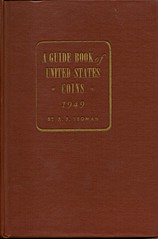 Whitman's Handbook of United States Coins (developed by marketing man Richard Sperry Yeo, later
known by his pen name, R.S. Yeoman) debuted in 1942, cementing Whitman as a numismatic publishing
firm of note. As Harvey Stack mentioned, Whitman's Guide Book of United States Coins (the "Red
Book," also by Yeoman) was rolled out in late 1946, with the second print run of its first edition
following hot off the presses in early 1947.
Whitman's Handbook of United States Coins (developed by marketing man Richard Sperry Yeo, later
known by his pen name, R.S. Yeoman) debuted in 1942, cementing Whitman as a numismatic publishing
firm of note. As Harvey Stack mentioned, Whitman's Guide Book of United States Coins (the "Red
Book," also by Yeoman) was rolled out in late 1946, with the second print run of its first edition
following hot off the presses in early 1947.
A few years ago at the Whitman Coin and Collectibles Philadelphia Expo, longtime editor Ken Bressett and I gave a talk on the history of the Red Book. David Lisot taped our presentation and the Q&A session afterward. You can find the 42-minute video at www.coinvideo.com as catalog #WHIT09-005.
For E-Sylum readers who are interested in Whitman and Western, I recommend Frank J. Colletti's Guide Book of the Official Red Book of United States Coins, which is chock full of hobby and publishing history; and Leonard S. Marcus's Golden Legacy: How Golden Books Won Children's Hearts, Changed Publishing Forever, and Became An American Icon Along the Way. The latter book focuses on another famous Western Publishing line (Little Golden Books), but has a good amount of general company history.
To read the earlier E-Sylum article, see: HARVEY STACK ON NUMISMATICS IN 1947 (www.coinbooks.org/esylum_v15n16a13.html)
JORDAN TO SPEAK ON AMERICAN NUMISMATIC ICONOGRAPHY
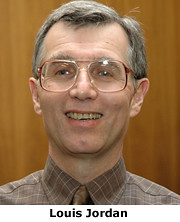 On Sunday, May 6, the Friends of Princeton University Library will sponsor a public lecture by the
noted scholar of early American coinage, Louis Jordan, entitled "Transformations in Numismatic
Iconography during the American Revolution." The talk will take place at 4 p.m. in 101
McCormick Hall on the Princeton campus. The lecture will be preceded at 2:30 by a curatorial tour
of the exhibition "Capping Liberty: The Invention of a Numismatic Iconography for the New
American Republic" by Alan M. Stahl, Princeton's Curator of Numismatics, in the Leonard L.
Milberg Gallery of Firestone Library, Princeton University.
On Sunday, May 6, the Friends of Princeton University Library will sponsor a public lecture by the
noted scholar of early American coinage, Louis Jordan, entitled "Transformations in Numismatic
Iconography during the American Revolution." The talk will take place at 4 p.m. in 101
McCormick Hall on the Princeton campus. The lecture will be preceded at 2:30 by a curatorial tour
of the exhibition "Capping Liberty: The Invention of a Numismatic Iconography for the New
American Republic" by Alan M. Stahl, Princeton's Curator of Numismatics, in the Leonard L.
Milberg Gallery of Firestone Library, Princeton University.
Louis Jordan is one of the pre-eminent experts on the coinage of the early American Republic. In addition to his many public lectures and publications on the topic, he maintains an extensive scholarly website: "The Coins of Colonial and Early America" (http://www.coins.nd.edu/ColCoin/index.html/).
Dr. Jordan is Librarian and Director of Special Collections, University of Notre Dame Libraries, the institution from which he received his Ph.D. in Medieval Studies in 1980. He is co-editor of and a frequent contributor to The Colonial Newsletter: A Research Journal in Early American Numismatics, and author of John Hull: The Mint and the Economics of Massachusetts Coinage (2002) and Lord Baltimore Coinage and Daily Exchange in Early Maryland, currently in preparation.
In his talk at Princeton, Jordan will trace the various attempts by the Continental Congress to devise a symbol for the new Republic, including the devices of a linked chain and a sundial invented by Benjamin Franklin, which were adopted on the 1776 Continental Currency patterns and on the 1787 Fugio coppers. Another common motif, the circle of stars representing the colonies and then states, appeared on the Nova Constellatio coppers and became the basis of the first United States flag.
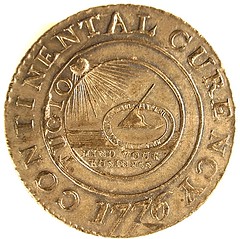
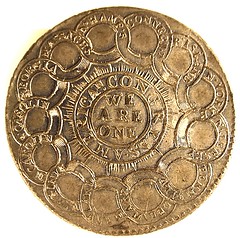
The lecture is being held in conjunction with the exhibition "Capping Liberty," which is running through July 8, 2012, in the Leonard L. Milberg Gallery of Firestone Library, Princeton University. Hours are Monday through Friday, 9 a.m. to 5 p.m., Saturday and Sunday, noon to 5 p.m., closed holidays.
The exhibition and its associated events are free and open to the public. A website devoted to the exhibition, including high-resolution images of both sides of all coins on display and images from associated books, manuscripts, and graphic arts, is online at http://rbsc.princeton.edu/capping-liberty and will remain on the site after the close of the exhibition. Further information can be obtained from Alan Stahl, Curator of Numismatics, at astahl@princeton.edu or (609) 258-9127.
Alan adds:
Our website is now ready for prime-time. We've replaced all of the coin photographs and, thanks to helpful comments from some E-Sylum readers, have made corrections to some of the text. The website is an ongoing publication, so further comments and corrections will be greatly appreciated.
To view the updated web site, see: rbsc.princeton.edu/capping-liberty/
EXHIBIT: PANORAMIC VIEWS ON EUROPEAN COINS AND MEDALS
CITYSCAPES
Panoramic Views on European Coins and Medals
27 April 2012 - 6 October 2013
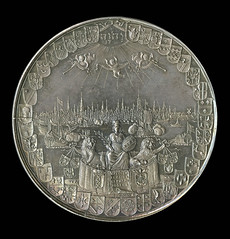 London, Amsterdam, Hamburg, Barcelona, Venice and Budapest… Explore the historical landscapes of
all these cities - and more - in Cityscapes: Panoramic Views on European Coins and Medals at the
Barber Institute of Fine Arts.
London, Amsterdam, Hamburg, Barcelona, Venice and Budapest… Explore the historical landscapes of
all these cities - and more - in Cityscapes: Panoramic Views on European Coins and Medals at the
Barber Institute of Fine Arts.
The third in a series of prestigious shows organised in collaboration with the British Museum, Cityscapes highlights how, between the mid 16th century to the early 19th century, many of the great cities of Europe applied the artistic tradition of the city view to their own coins and medals - the most circulated art medium. In a world dominated by dynasties and kings, these gave physical expression in silver and gold to urban pride and civic power and showcase the exquisite skill of engravers working without modern technology.
The absorbing exhibition includes 100 loans from the British Museum, as well as objects from the Barber's own coin collection - one of the finest collections of Roman, Byzantine and medieval Islamic coins in the world. The wonderfully intricate images in Cityscapes feature churches, citadels, fortifications, harbours, civic buildings, houses and suburbs, emphasising military or commercial power, wealth, strength and above all, divine protection and favour.
The exhibition at the University of Birmingham-based Barber Institute is accompanied by a rich and diverse programme of educational activities, lectures, gallery talks, concerts and film screenings. Cityscapes is also complemented by an online exhibition, which can be visited at www.barber.org.uk/coins
Dr Eurydice Georganteli, Coin Curator, the Barber Institute of Fine Arts said: "Cities are possibly the most complex artefacts created by human intervention, shaped by geography, as well as economic, political and cultural considerations. Profound changes in the function of cities over the last two centuries have led to a steady deconstruction of the urban environment and to the cultivation of cultural amnesia. As an art historian I have always been struck by the divergence between civic pride displayed on ancient, medieval and early modern coins and medals, on one hand, and the apathy or aggression expressed by modern citizens vis-à-vis the space they inhabit."
Dr Barrie Cook, Curator of Medieval and Early Modern Coinage, the British Museum added: "This exhibition is a celebration of technical mastery, with the engravers of early modern Europe creating these city-views, simultaneously both intricate and panoramic, in such a small compass as the diameter of a coin or medal. Furthermore, they created them in three dimensions - the relief on the objects, however low, offers a depth and a gleam to the city view not present in two- dimensional media."
'I also hope visitors get a sense of an alternative history of early modern Europe. This wasn't just a world of kings, dynasties and great powers. It was one of lively and independent cities, and this is a part of Europe's past that is often overlooked.'
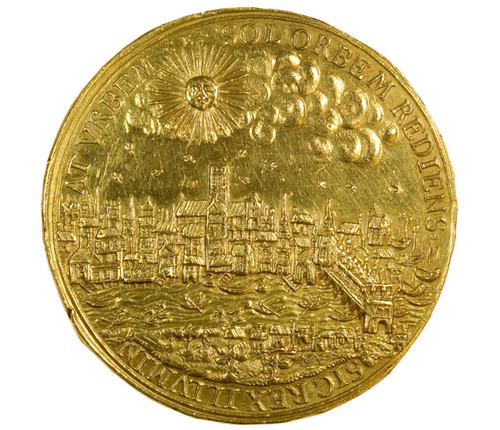 Gold medal of London, struck in 1633, by Nicolas Briot.
Gold medal of London, struck in 1633, by Nicolas Briot.
Coins and Medals, the British Museum
Ben adds:
Unfortunately, there won't be a catalogue for this exhibition, but there will be an online exhibition that will launch soon after the 'physical' show at www.barber.org.uk/coins - therefore, your readers who can't get to our exhibition can still enjoy the highlights online.
For more information, see: www.barber.org.uk/cityscapes.html
SHAKESPEAREAN NUMISMATICS AT THE BRITISH MUSEUM
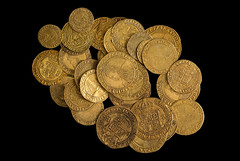 This display explores the role of coins and money in Shakespeare's works, as well as illustrating
how money and medals marked the major events of the late Elizabethan and Jacobean world.
This display explores the role of coins and money in Shakespeare's works, as well as illustrating
how money and medals marked the major events of the late Elizabethan and Jacobean world.
Shakespeare's plays are full of coins, from the English crowns to the Venetian ducat, and references and metaphors were constantly related to money and coins as a way of indicating identity, legitimacy and reputation. More specifically they were used as a means of plot development, as audiences were expected to recognise the coins that were featured and pick up on messages about value, wealth and character.
In The Merchant of Venice for example, which begins with the fateful loan of three thousand ducats made by Shylock to Antonio, the audience is assumed to know what a ducat is worth (about £100 today) and what the stakes are. In almost every scene that features Falstaff in Henry IV, there contains a monetary reference or joke that reflects on his character and role; from tipping with a notoriously bad coin, 'Hold, there's a tester for thee', to defending himself through a money metaphor, 'Dost thou hear, Hal? Never call a true piece of gold a counterfeit. Thou are essentially mad, without seeming so.'
The role of money in the Elizabethan and Jacobean theatre will also be explored in this display. In many respects Shakespeare and his generation invented commercial theatre as part of a new world of public entertainment that was dependent on popular appeal whilst also firmly linked to the royal court. Medals, for example, were quite new in England and were given out and worn as signs of allegiance and fidelity, a fact that adds further bitterness to the reference Shakespeare uses in The Winters Tale when King Leontes's jealously describes his wife as hanging round the neck of the visiting King of Bohemia, 'Why, he that wears her like a medal hanging / About his neck, Bohemia'.
Objects on display include Nicholas Hilliard's 'Dangers Averted' medal of Elizabeth I and William Roper's print of Elizabeth, which was the first print to be dated and signed by an English artist. There is an example of the sort of money box that would have been used at the Globe Theatre; as well as a hoard of gold coins that was deposited in Essex around the time of Shakespeare's birth which includes a Venetian ducat. Nearly every type of coin mentioned in Shakespeare's plays, from 'crack'd drachmas' to 'gilt twopences' will also be on display.
Curator Barrie Cook said, 'This exhibition began as an attempt to investigate what Shakespeare tells us about the coins of his time. What I hadn't realised was, and what is so wonderful, is that when he talks about coins, he is as likely to be commenting on the people around him as about money."
To read the complete article, see: Crowns and ducats: Shakespeare's money and medals at the British Museum (www.artdaily.org/index.asp?int_sec=2&int_new=54834)
QUERY: LITERATURE ON PALESTINIAN NUMISMATICS
Scott Barman writes:
I was going through some old collectibles and found I have a a few coins from Palestine from the time of the British Mandate. I'm looking for some good reading material on coins of that era. I found one book, "The Coins and Banknotes of Palestine Under the British Mandate," by Howard Berlin. Do you know if there any others?
Howard writes:
My book is now the paperback edition (2005), available from either Amazon.com http://www.amazon.com/gp/product/0786424451/ref=ed_oe_p/002-1489852-7287231?_encoding=UTF8 or the publisher for $49.95 + s/h http://www.mcfarlandpub.com/book-2.php?isbn=0-7864-2445-1
The only other up-to-date authoritative book is by Rafi Dabbah, an Israeli. It is strictly on the banknotes. It is a bit pricey ($250 - hardback w/slip cover) from Amazon (The English version). I got mine gratis from the author as we are close friends. I saw a copy or two in Spink's London store but I don't know the price.
As far as I know, there have been a few articles here and there (in the past two or three years
about the notes (by me as they relate to the vignettes in Paper Money Values) and a 3-part article
by Mark Fox about the coins in general in 2011 World Coin News (reprinted Numismaster):
www.numismaster.com/ta/numis/Article.jsp?ad=article&ArticleId=17480
www.numismaster.com/ta/numis/Article.jsp?ad=article&ArticleId=18882
www.numismaster.com/ta/numis/Article.jsp?ad=article&ArticleId=19721
Watch it on YouTube: Annie Hall (1977) scene with Marshall McLuhan (www.youtube.com/watch?v=9wWUc8BZgWE)
PREMIUMS PAID FOR POSTAGE AND FRACTIONAL CURRENCY
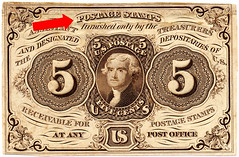
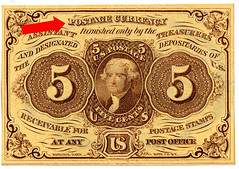
I'd like to respond to Peter Huntoon's query in the November 27th, edition of The E-Sylum. The question was based upon an exchange he was having with Fred Reed as to the premiums being advertised for the purchase of postage and fractional currency. Mr. Huntoon was seeking Treasury tables/etc. outlining a premium difference between postage and fractional currency, speculating that the premium was due to postage currency's value being used to meet customs duties whereby fractional currency could not be used for that purpose.
While the Act of July 17, 1862 is often identified as the enabling act for the issuance of postage currency, this is incorrect. The Act itself only authorized postal 'stamps'. Samuel P. Chase and Francis E. Spinner creatively interpreted this as the means that allowed them to issue facsimiles of the current postal stamps as a method to provide for the commercial exchange of value in amounts of less than $1 (i.e. fractional monies).
The use of 'stamps' to pay customs fees and duties is a continuation of earlier legislation related to revenue stamps and is reflected in this act as well. Because Chase/Spinner proposed the use of the 'stamps' as a basis for commerce involving fractional values less than $1, so did the relationship of using the first issue of postage currency to satisfy customs taxes. This is reflected in the engraving on the notes themselves.
When the Act of July 17, 1862 took effect on August 1st, 1862 it also made the manufacture, issue, circulation or use of other obligations for value less than one dollar unlawful and included provisions for fines and jail penalties. So effectively merchants, banks, etc. were facing these fines and penalties yet had nothing else to facilitate commerce in amounts less than $1.
The first issuance of the new postal currency was through an Army Paymaster, on August 21st, 1862. The direct release to the general public began about 2 weeks later, or in early September, 1862. (I've seen a newspaper report of this but have not been successful in relocating it.) However, the volume of available notes was insufficient to meet the demands. The sheets printed and delivered from the bank note companies were being hand-cut by Treasury staff, which was time- consuming. As such, private scrip and postage stamps continued to circulate. It wasn't until late December, 1862 when the National Currency Bureau's output had reached upwards to $100,000 a day did the demand begin to lessen and the use of private scrip rapidly disappeared.
The demand for the new fractional currency issued by the Treasury was driven primarily by two factors. First were the obvious penalties and fines associated with the use of the privately issued scrip. But more importantly, there also was the public's fear that the private scrip would become worthless overnight - the merchant/issuer would no longer honor it due to the fines and penalties. So there was significant public pressure to exchange what they had and to transact with merchants using only the new Treasury issued postage currency. In turn, merchants couldn't keep up with their customer's needs and the banks couldn't obtain sufficient quantities from the Treasury to satisfy the merchants.
Advertisements began to appear whereby merchants and even individuals would offer a premium over face value for quantities of the new postage currency. Merchants needed the new currency to handle their commercial needs as well as the demands for it in exchange to retire the private scrip they had previously issued. Individuals wanted it because they felt it would hold value as oppose to private scrip issued by a merchant that could go out of business. Gold and silver coinage had long since disappeared and copper was also becoming scarce as people had begun hoarding it as well. (There's an interesting story of a New York merchant whose 1st floor fell into the basement of the building due to the weight of all the coin they had hoarded... but I digress.)
While indeed the postage currency was and could be used for payment of customs, the commercial need and the concern as to the loss of value of the existing scrip was the main driving force behind the offer of premiums for the new postage currency.
Postage Currency itself was actually never authorized by Congress. It was not until the Act of March 3rd, 1863, when Congress actually authorized the issuance of 'fractional currency'. In doing so the act explicitly did not authorized it to be accepted for payment of customs duties.
Lucius Chittenden, Register of the Treasury during the Civil War, wrote an article for the "Harper's New Monthly Magazine" (October, 1890; Vol. 81, No. 485; page 699) entitled "New Moneys of Lincoln's Administration". It gives some interesting insight into the government's finances during this time as well as how Lincoln was troubled by coming up with the funds needed to support the war effort. The text of his article can be viewed at: www.yamaguchy.com/library/spaulding/chittend1890.html .
Finally, when Francis Spinner was exploring the concept of producing notes of fractional amounts based upon the postage stamps of the time, the initial essay notes produced as examples were actually titled "Postage Stamps". (See example) These were shared with various people, including Montgomery Blair, Postmaster. However, the title was changed to "Postage Currency" in the final design. The extremely rare "Postage Stamps" essays may truly be the only form of the 1st issue that might be considered as duly authorized by the Act of July 17, 1862, and thereby can be used to satisfy customs fees.


To read the earlier article, see: QUERY: PREMIUMS PAID FOR POSTAGE AND FRACTIONAL CURRENCY (www.coinbooks.org/esylum_v14n49a11.html)
MORE ON THE JOHN ORTH 'BIT' DENOMINATION TOKENS
Last week Dave Schenkman described a token from his denomination collection:
This is one of the neatest; a 37mm silver token with one dollar expressed as 8 bits, with a bit on each of the three horses and 5 bits below. The Seattle merchant that issued it, John W, Orth, also issued tokens with one bit (12½¢) depicted.
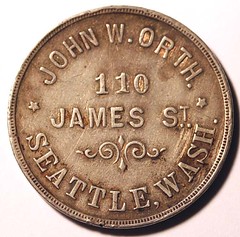
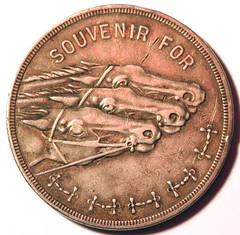
David Schenkman's Orth token
Dick Hanscom writes:
I was really surprised to see the Orth 3-horse, 8-bit token in The E-Sylum. I have seen it before, but had completely forgotten about it. It is in the "way cool" category.
Which brings me to why I am writing. Last Saturday I received a 1 bit token from an online auction. I bought it because I thought I had the die. Come to find out I have a 1 bit die, but it does not match the token. When I saw the 8 bit token on Sunday, I did a double take. I did not realize that the 1 bit that I had purchased was from the same issuer, and would not have made the connection had it not been in The E-Sylum.
I've attached images of my bit die, a lead impression from the die, and the obverse and reverse of my Orth bit token.
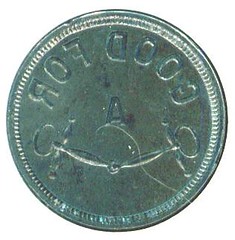
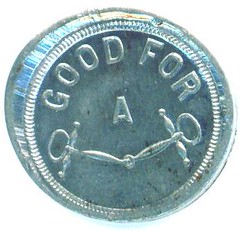

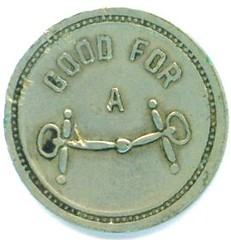
To read the earlier E-Sylum article, see: WAYNE'S NUMISMATIC DIARY: APRIL 15, 2012 (www.coinbooks.org/esylum_v15n16a17.html)
QUERY: INFORMATION ON LONGINES WITTNAUER MEDALS SOUGHT
 I am cataloging the family collection of medals created by Joseph DiLorenzo (1920-2001) for a
possible exhibition. While the bulk of DiLorenzo's medallic work was struck by Medallic Art
Company -- and I have these records -- he also did two series for Longines Wittnauer. This was the
famed watch firm, which, prior to the American Bicentennial, ventured into medal issuing for a
brief time.
I am cataloging the family collection of medals created by Joseph DiLorenzo (1920-2001) for a
possible exhibition. While the bulk of DiLorenzo's medallic work was struck by Medallic Art
Company -- and I have these records -- he also did two series for Longines Wittnauer. This was the
famed watch firm, which, prior to the American Bicentennial, ventured into medal issuing for a
brief time.
For the most part the medals were issued under the Wittnauer name and carried a W as their hallmark. They were struck by Metal Arts of Rochester and bear a maker's mark of a lower case a. Further, the medals are also signed with the initials of the sculptor who prepared the models. So they are easily identified.
Wittnauer issued three presidents medals in 1973-74, two Washington medals in 1975, that I have a record of, and a series of America's Natural Legacy Series, begun in 1972. The latter series was in conjunction with the Sierra Club which selected the animal species shown on each medal. Sculptors for this series was divided between Marcel Jovine and Joseph DiLorenzo. The two sculptors were friends, lived in nearby towns, and shared commissions, as is evident in this series.
The medal series I need more data on is the Great American Triumph Series. I have a list of all 60 medals in the series, but I have no documentation for the years in which these were issued. Harry Flower dated the Einstein Medal in this series (number 41) as "1971" in his collection, published 1987.
Ideally I seek:
- Photocopies of any sales literature, advertisements, direct mail offering of ANY Wittnauer medals.
- Dates a subscriber received these medals in the Great American Triumph Series.
- Possible contact with a former employee of Longines Wittnauer who might recall any data on the firm's medal issuing activity.
Thanks! dick.johnson@snet.net .
HARVEY STACK RECALLS HARRY W. BASS, JR
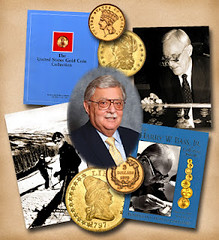 Harry W. Bass, Jr. was a great numismatist and scholar. He loved United States gold coins.
Studying the many varieties of early coins was his special interest and in time he built the
largest collection of early gold coin die state varieties ever assembled.
Harry W. Bass, Jr. was a great numismatist and scholar. He loved United States gold coins.
Studying the many varieties of early coins was his special interest and in time he built the
largest collection of early gold coin die state varieties ever assembled.
He enjoyed visiting the Stack family whenever he was in New York. He spent hours studying our inventory and photo library.
Harry was a good friend and client. He also gave Stack's the opportunity to be one of his agents at the United States Gold Coin Collection (Louis Eliasberg Collection) sale, held in New York in 1982. Harry was sure that if he bid himself, others not as knowledgeable as him would use his bidding as a "crutch" to bid against him. He didn't want to educate his competition.
Harry asked me to represent him at the sale and gave me a list of special lot numbers he wanted me to bid on. When I asked him for his limits, he said "Just watch me." We made up a special signal. He wore his jacket and a handkerchief in his breast pocket. Whenever we came to a lot he wanted, he would signal by touching the handkerchief in his pocket. When he removed his hand, I was to stop bidding. I could only bid when he was touching his handkerchief.
I was not sitting near him. He sat in the front row and I positioned myself five rows behind him with a good view of the handkerchief in his pocket. The plan worked perfectly for the first part of the sale and I acquired for him a good many coins.
The tense moment arrived when the unique 1870-S three-dollar gold coin was offered. I knew from my list to bid on it. When the bidding opened at about $120,000 and started to advance toward $200,000, Harry did nothing. I waited. As the bidding approached $300,000, he moved his hand to the handkerchief and held on to it. I began bidding and continued in $25,000 increments until it reached $425,000, and suddenly his hand dropped, and the bidding advanced to $500,000. Once again, Harry's hand returned to the handkerchief and dropped after I bid $575,000 for him.
A bid came at $600,000 and the room gasped. Harry didn't move. The auctioneer was calling for "anymore" and just as the gavel was about to drop, Harry's hand returned to the handkerchief and I immediately bid $625,000 and won. The applause that followed showed the excitement we all felt in the room. Stack's was given credit for the purchase, and it was only later that year that Harry revealed that he was the buyer.
Whenever Harry came to New York, he would stay at the Hotel Salisbury, which is immediately adjacent to our 57th Street store, so he visited us often. In fact, when he was working at the American Numismatic Society on a pet project he had, developing a computer inventory of the Society's coins, he would spend months in New York. The Society closed each day at 4:00 pm. Harry would take a cab over to our offices, sit and talk numismatics with the Stacks, until closing each evening at 5:30 pm. These casual conversations only enhanced our friendship and gave us greater understanding of Harry's love for his collection and collectors.
To read the complete article, see: Remember When: Harry W. Bass, Jr. (stacksbowers.com/Blogs/remember-when-harry-w-bass-jr.html)

NOTES FROM E-SYLUM READERS: APRIL 22, 2012
More on Verne Walrafen
Sandy Pearl writes:
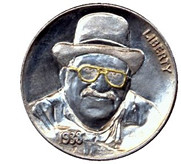 The article on Verne Walrafen was a fitting tribute to a wonderful person. Verne was a tireless
worker for the Original Hobo Nickel Society as our secretary and web master but he was a lot more.
He helped many club members learn more about Hobo Nickels, helped a number of nickel carvers
develop their techniques and was an active board member that quickly cut to the chase in a
diplomatic, logical and effective manner. He was a nice guy - happy, friendly and considerate. It
was a pleasure working with him.
The article on Verne Walrafen was a fitting tribute to a wonderful person. Verne was a tireless
worker for the Original Hobo Nickel Society as our secretary and web master but he was a lot more.
He helped many club members learn more about Hobo Nickels, helped a number of nickel carvers
develop their techniques and was an active board member that quickly cut to the chase in a
diplomatic, logical and effective manner. He was a nice guy - happy, friendly and considerate. It
was a pleasure working with him.
Ray Williams writes:
I saw the obit for Verne R. Walrafen and was sorry to hear of his passing. We never met but we had a lot of communications about Gallery Mint products. He has a website dedicated to the Gallery Mint: www.gmmnut.com/gmm/rl.html .
There are some that do not appreciate the reproductions that the Gallery Mint made, but when I take my Red Book type set of NJ coppers to give a talk, a Gallery Mint "Date Under Plow Beam" and a "WM Variety" make it complete.
For 2002, the 350th Anniversary of the Boston Mint, I had the Gallery Mint make a punch for me. It is the script "NE" which is on the earliest of the Boston coinage. To commemorate the anniversary, I counterstruck NY State Quarters at the C4 Meeting at the 2002 NY ANA Convention. I also counterstruck MA State Quarters at the 2002 C4 Convention in Boston. You can see an example at www.gmmnut.com/gmm/gmm48.html .
For those that have an interest in counterstruck coins, there is a list of what and how many counterstruck coins I made. I plan to counterstrike no more, BUT if I live to be exactly 100, I will counterstrike more coins in 2052 to commemorate the 400th Anniversary of the Boston Mint. There's so many ways to have fun in this hobby!
To read the earlier E-Sylum article, see: VERNE R. WALRAFEN 1940-2012 (www.coinbooks.org/esylum_v15n16a07.html)
Superman Check Sells For $160,000
Tom Fort writes:
The cheque paid to Superman's creators Jerry Siegel and Joe Schuster for the rights to their creation sold at auction for $160.00. I suspect that this is the most ever paid for a cheque. If I am wrong I am certain that you, or someone else knows the correct answer. The link to the article is here: Check that bought Superman rights sells for $160,000 (robot6.comicbookresources.com/2012/04/check-that-bought-superman-rights-sells-for-160000/).
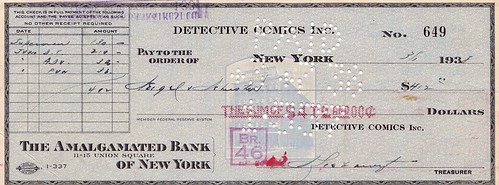
The St. Cuthbert Gospel
On bibliophilic topic Tom Fort writes:
This story was on NPR earlier this week. The British Library recently paid £ 9,000,000 (about $14,000, 000) for the St. Cuthbert Gospel, the earliest surviving bound book known. It dates from 698 and has survived to today. This may well be the most amount of money ever paid for a book.
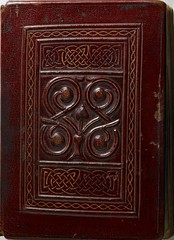 The Gospel, which is a manuscript copy of the Gospel of St John, is the earliest intact European
book and is intimately associated with Cuthbert, one of Britain's foremost saints. It was created
in the late 7th century in the north-east of England and placed in St Cuthbert's coffin,
apparently in 698. It was discovered when the coffin was opened in Durham Cathedral in 1104 on the
occasion of the removal of Cuthbert's body to a new shrine. The Gospel has a beautifully-worked,
original, red leather binding in excellent condition, and is the only surviving high-status
manuscript from this crucial period in British history to retain its original appearance, both
inside and out.
The Gospel, which is a manuscript copy of the Gospel of St John, is the earliest intact European
book and is intimately associated with Cuthbert, one of Britain's foremost saints. It was created
in the late 7th century in the north-east of England and placed in St Cuthbert's coffin,
apparently in 698. It was discovered when the coffin was opened in Durham Cathedral in 1104 on the
occasion of the removal of Cuthbert's body to a new shrine. The Gospel has a beautifully-worked,
original, red leather binding in excellent condition, and is the only surviving high-status
manuscript from this crucial period in British history to retain its original appearance, both
inside and out.
To read the complete article, see: St Cuthbert Gospel Saved for the Nation (britishlibrary.typepad.co.uk/digitisedmanuscripts/2012/04/st-cuthbert-gospel-saved-for-the- nation.html)
Bill Dings
Katie de Silva writes:
This was shared on someone's Facebook page - have no idea of the source.

The Georg Hulbe Leather Medal Error
Regarding the error on the Georg Hulbe Leather Medal, Joe Boling writes:
 On the Georg Hulbe medal, 20 first prizes, not prices. In The E-Sylum, it
looked like there was an (incorrect) umlaut on the U of Hamburg, but on the Flickr archive, I can
see that there is not. Also, I loved the item on the Sultan of Swat. The silver coin should have
been 714 homrens.
On the Georg Hulbe medal, 20 first prizes, not prices. In The E-Sylum, it
looked like there was an (incorrect) umlaut on the U of Hamburg, but on the Flickr archive, I can
see that there is not. Also, I loved the item on the Sultan of Swat. The silver coin should have
been 714 homrens.
Ginger Rapsus writes:
The medal said "first prices" instead of "first prizes."
John Mutch, Philip Mernick, Ken Spindler, and Jim Duncan also spotted the missing "prices". Jim adds:
I don't much like PURVEYOR OF either, surely TO is righterer.
To read the earlier E-Sylum article, see: NOTES FROM E-SYLUM READERS: APRIL 15, 2012: Leather Medal of Georg Hulbe (www.coinbooks.org/esylum_v15n16a15.html)
COINSWEEKLY ARTICLE SPURS CLEANUP OF GREEK TEMPLE SITE
A short time ago we reported in CoinsWeekly on an intriguing temple of Aphrodite in the heart of Thessaloniki, a temple that, alas!, was sinking into rubbish because the responsible Archaeological Service did not do anything to preserve and conserve it. A citizen initiative had some plans but they had to deal with many adverse directives.
Now one of these activists has informed us that our article caused quite a stir in the Greek bureaus of the Antiquity administration causing facts at last. The competent department gave those engaged persons permission to cleanse all the waste and rubbish of the monument in their immediate neighbourhood.
And there was no need to tell the men and women twice, they snapped the chance! At the end not only a lot of plastic bags were brimmed, ...but the very temple was visible again.
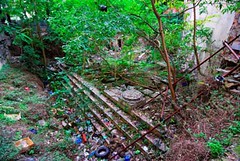
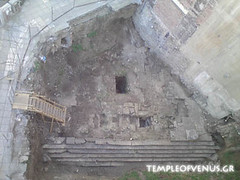
Before and After
These people engaged actively in the interest of the preservation of cultural property in their neighborhood. Hopefully the Archaeological Service will follow their good example contributing to the preservation of that monument which can tell us much and will certainly attract tourists if it was only conserved properly and made known.
However, we are glad that our article has caused more than one could expect - considering internet publications as uncoupled from the "real" world. And, naturally, we will continue to support activities of this kind in the future!
To read the complete article, see: Temple of Aphrodite in Thessaloniki cleansed (www.muenzenwoche.de/en/page/4?&id=1157)
For images of the temple cleanup operation, see: www.templeofvenus.gr/el/temple/photos/category/2-templeofvenus2
To read the earlier CoinsWeekly article, see: Thessaloniki fights for its cultural future (www.coinsweekly.com/en/Thessaloniki-fights-for-its-cultural-future/4?&id=903)
UTAH GOVERNOR SIGNS GOLD AND SILVER COIN LEGAL TENDER ACT
Online, Marketplace cited this article as background for their story:
In practice, in Utah, individuals will be able to use gold and silver bullion in the same way as they would cash for transactions but also for currency exchanges. Individuals with the metal will be able to get fair market value in a trade for cash, or may start depositing or paying with it. The state will also be offering a one-time tax credit to offset any capital gains taxes accrued for individuals who choose to trade metal for paper.
The tax credit essentially ensures that the exchange works like any other currency exchange, say if someone went to Europe and needed to get Euros around that trip. It will also eliminate a shadow market for the metal as those with metal to exchange would normally call around for transaction prices in order to offset fees and taxes.
To read the complete article, see:
Utah to accept gold & silver bullion as currency, move highlights broader financial realities in
US
(civsourceonline.com/2012/04/19/utah-to-accept-gold-silver
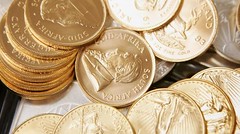 This final note on the way out. The governor of Utah signed a bill this week making gold and
silver legal tender.
This final note on the way out. The governor of Utah signed a bill this week making gold and
silver legal tender.
We were curious about exactly how that might work. So we called Craig Franco, he runs the Utah Gold and Silver Depository. It's a bank -- kinda.
Craig Franco: Nice to be with you.
Ryssdal: Just to be clear, this law does not let me take a nugget of gold and plop it down on the counter and buy a pair of jeans and a candy bar?
Franco: That is correct. The law is very specific on the type of gold product that's been monetized. And what has been monetized is American gold and silver coinage.
Ryssdal: Printed by or minted by who? The United States Mint?
Franco: The United States federal government.
Ryssdal: So I can have some 1792 gold, double-eagle, walking liberty coin, whatever they call 'em -- because you guys do special stuff, right? -- and plop it down on the counter?
Franco: Theoretically, yes. Now practically, that's impossible to do. So what we've done at the Utah Gold and Silver Depository is we have developed a debit card that allows for people to deposit their gold and silver like you would deposit cash in a bank. And we can issue a debit card against the value of your gold or silver holdings.
Ryssdal: I have to tell you, this takes literally all the charm out of it, man.
To read the transcript online, see: (www.marketplace.org/topics/life/final-note/utah-officially-makes-gold-and-silver-legal-tender)
To read the complete article, see:
U.S. Currency Backed by Gold and Silver? Yes, But the 'U' Stands for Utah
(www.dailyfinance.com/2011/05/26/u-s-currency-backed-by
-gold-and-silver-yes-but-the-u-
stands/)
Earlier this year, the Utah state legislature passed a law making gold and silver coins legal tender. Now, a Salt Lake City-area numismatist hopes to set up a system that will allow Utahans to use those precious metals to pay for anything they want.
Franco says he has encountered "a profound amount of interest" in his new service, "coming nationally, not just locally. We have received, in the last 48 hours since the AP article broke, inquiries from the East Coast to the West Coast, from private investors to asset managers."
Some details remain to be decided, including the exact fee schedule the depository will charge. Franco says clients will have 30 days to clear their accounts following transactions. When debiting, he'll use the spot price of the metal in question on the day a transaction is settled. "But the value of the account fluctuates on an hourly basis," Franco explained, "based upon the global market."
When it was passed in March, the Utah law was derided as an example of right-wing fringe thinking run amok. Political columnist Dana Milbank denounced it as one of several "curious formulas" mixed by "tea party chemists," akin to a Montana bill celebrating global warming, or an attempt to mandate gun ownership for all adults in South Dakota. Even its backers seemed to admit that its significance was largely symbolic.
And yet a dozen other states, from Virginia to Idaho, are said to be considering similar legislation, though the practical effects are limited.
To read the complete article, see:
U.S. Currency Backed by Gold and Silver? Yes, But the 'U' Stands for Utah
(www.dailyfinance.com/2011/05/26/u-s-currency-backed-by-gold
-and-silver-yes-but-the-u-stands/)
1792 SILVER CENTER CENT SELLS FOR $1.15 MILLION
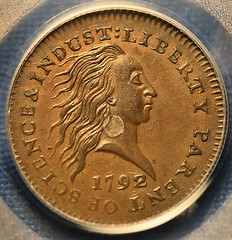 A centuries old coin, one of the first ever produced in the United States' Mint, was sold for a
whopping $1.15million at an Illinois auction on Thursday.
A centuries old coin, one of the first ever produced in the United States' Mint, was sold for a
whopping $1.15million at an Illinois auction on Thursday.
The famous 1792 silver-center cent was purchased by Kevin Lipton of Beverly Hills, California, on behalf of a group of unnamed investors.
On one side, the reddish-brown coin features Lady Liberty facing right with her hair flowing behind, and on the other, a wreath tied with a ribbon at the bottom encloses around the words 'ONE CENT.'
The first official coins entered circulation in February 1793, but a few experimental coins were minted as prototypes first.
The law at the time required pennies to contain 11 pennyweights of pure copper, equal to 17.1069 grams.
Rittenhouse realized that this size penny would be impossibly large and heavy, so he created alternative coins to present to Congress.
One solution was the silver-center cent, a penny with three fourths of a cent of silver surrounded by a quarter cent of copper.
It was rejected.
Congress reduced the official weight of the cent and only a few of the silver-center cents remain.
'There are only 14 known surviving silver-center cents, and this is the third finest known,' Todd Imhof, Executive Vice President of Heritage Auctions said.
In 1974, he added, the same coin sold for just $105,000.
To read the complete article, see:
Now THAT'S a pretty penny! Rare coin fetches $1.15million at auction
(www.dailymail.co.uk/news/article-2132690/Now-THATS-pretty
-penny-Rare-coin-fetches-1-
15million-auction.html)
Here's a nicer image with the holder cropped out:
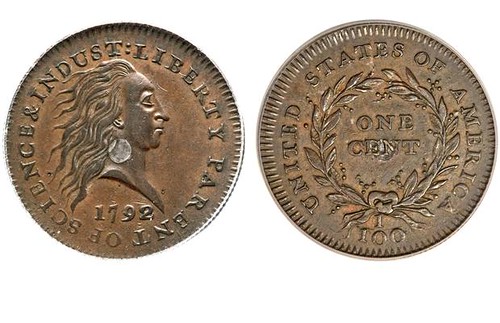
To read the complete article, see: U.S. penny sells for $1.15 million (www.vancouversun.com/penny+sells+million/6492905/story.html)
THE BOOK BAZARRE
CANADA INTRODUCES NEW COIN TECHNOLOGY

The Royal Canadian Mint announced April 10 that the long-awaited new $1 and $2 coins, featuring security measures for an increasingly digital world, would begin entering circulation the following day.
That announcement regarding the evolution of Canadian currency followed the unexpected jolt March 29 when the RCM announced it would end production of the 1-cent coin sometime in April.
The new $1 and $2 coins are being struck from the RCM's patented multi-ply plated steel alloy, which has already been in use for the 1-, 5-, 10- and 25-cent coins for about a decade.
The composition features a steel core with alternating layers of metals such as copper, nickel and brass. The resulting coins are more durable and secure than other compositions and more economical to produce, according to the RCM.
Perhaps the most tantalizing aspect of the new coinage, and the area that could be the most misunderstood, is a patented process that has been branded as Digital Non-Reactive Activation.
The RCM first publicly acknowledged the DNA technology in background information buried at its website with the April 10 announcement about the new coins, where it discussed the debut of the technology despite the fact that, according to one spokesperson, it is not ready to be fully implemented.
If the system were to be implemented, this data could be stored in a database and used to confirm the authenticity of every coin manufactured by the RCM even as the coin experiences normal wear during its life cycle.
To read the complete Coin World article, see: Canada introduces newest coin technology (www.coinworld.com/articles/canada-introduces-newest-coin-technology/)
To read the Mint's web page announcement, see: New $1 and $2 Background (www.mint.ca/store/mint/learn/background-6800008)
EBAY'S COIN AUCTION RULE CHANGES
eBay no longer accepts ICG as a legitimate grading service (www.coincommunity.com/forum/topic.asp?TOPIC_ID=116778)
eBay Announces Changes to Listings Policy for Coins (news.coinupdate.com/ebay-announces-changes-to-listings-policy-for-coins-1322/)
eBay Announces New Changes for Coins Listed in Auction (www.coinweek.com/news/auctions-news/ebay-announces-new-changes-for-coins-listed-in-auction/)
eBay Tightens Grading Rules (www.numismaster.com/ta/numis/Article.jsp?ad=article&ArticleId=25109)
On a related note Harvey Stack adds (IN ALL CAPS!):
THE CURRENT ACTION BY E BAY, BANNING COPIES, REPLICAS, COUNTERFEITS AND THE LIKE FROM THEIR WEB SITES, IS TO ME THE FIRST STRONG ACTION TO STOP THE DAMAGE THAT THE FALSE AND REPLICA COINS HAS DONE TO THE NUMISMATIC INDUSTRY
I think back to 1973 when I who was appointed as the Coin Industry's sole representative to testify before the Congress of the United States, as to the dangers and evils of not enforcing false coins sales in the United States. I remember telling the Congress that these false items, counterfeits, copies and the like were deceiving the collectors, young and old, beginners and advanced hobbyists, who were lead to believe that these replicas were possibly or actually real.
The actions taken by Congress almost 4 decades ago, not only for the coin industry, but for those who collected antique glass, artifacts from the ancient times to the current century. paintings, and other art items.to get economic presser on the marketing companies to take actions against the sale and promotion of these false items.
To me it is strange that took almost 40 years to get this matter somewhat under control. I could not count, or dare to estimate how many millions of dollars where spent and therefore wasted on these false and to me valueless items.
As an old time numismatist, who loves the hobby, the coins and paper money that is part of it, the collectors, writers and all those connected with Numismatics, I am delighted that FINALLY some concrete actions are being taken to restrict the cause of many of the abuses, the loss of the next generations of collectors who were burnt by these items, and left the hobby.
HELL BANKNOTE SEEN AS THREAT
The unscrupulous actions of certain quarters who have threatened MCA Vice-President Dato' Sri Dr Ng Yen Yen by sending a 'hell note' to her office must be severely condemned as they have started a bad precedence for the community through their irresponsible actions.
Although it is not clear why the threat was made and it is unsure if the perpetrator was being manipulated, intimidation is still illegal, and as such, I call on these people to put an end to such offensive actions.
Sending 'hell notes' could be deemed as a psychological harassment and violence of the lowest degree which is intolerable.
Such threat is an act of violence which may cause mental distress to the receiver, and will leave a black mark on our country's political culture.
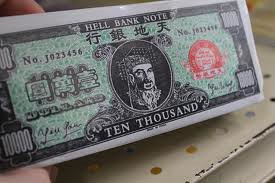
To read the complete article, see:
Who sent Ng Yen Yen a Hell's Banknote - MCA points finger at Pakatan
(www.malaysia-chronicle.com/index.php?option=com_k2
&view=item&id=32414:who-sent-ng-yen-yen-
a-hells-banknote
-mca-points-finger-at-pakatan&Itemid=2)
For more information on Hell money. See: HELL BANK NOTES (HELL MONEY) (www.luckymojo.com/hellmoney.html)
BURIED NUMISMATIC TREASURE
You never know what people might ask for when planning a funeral for a loved one.
In his 43 years at Layne's Funeral Home, Denton Harlan has taken requests for a host of odd things -- including some that make burials with liquor bottles, rare coins or stuffed animals seem almost routine.
One time, he had a customer ask him if he could load a loved one's ashes into a miniature metal cannon that he kept on his desk. When Harlan modified it, the guy liked the makeshift urn so much he asked for a second cannon for a relative.
To read the complete article, see: A most rewarding undertaking (www.columbian.com/news/2012/apr/14/a-most-rewarding-undertaking/)
FEATURED WEB PAGE: INDIAN PRINCELY STATES AND COINS
This week's Featured Web Page is recommended by P.K. Saha, who writes:A friend of mine has built a blog on Indian Princely States and coins.
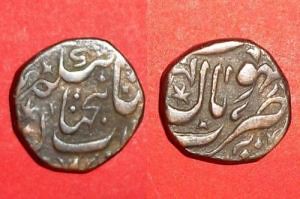
A quarter Anna coin from Shah Jahan Begham 1868-1901
princelystatecoins.wordpress.com
